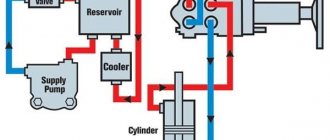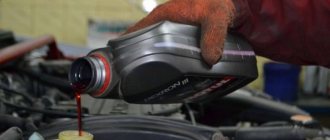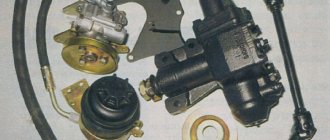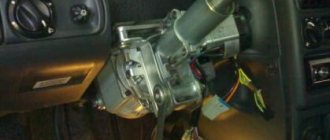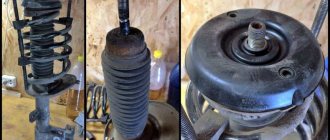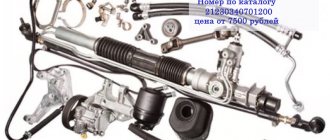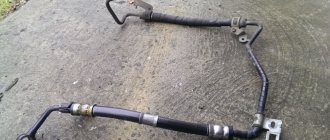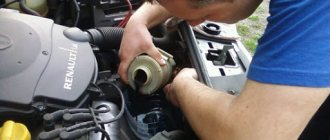In this article we will talk about the power steering system and structure, discuss the issue of replacing the power steering pump and modernization.
Those car enthusiasts who have driven a car for a long time without this device, and then switched to a foreign car with this function, will immediately notice a significant difference in control. Power steering helps solve several problems at once: the steering process no longer requires much effort, maneuverability increases and the turning trajectory is reduced.
As it turned out, the presence of a hydraulic booster in a car is a very positive thing, however, like other functions, there comes a time when the amplifier fails. The most common problems are: unpleasant noise when turning the steering wheel, leakage of hydraulic fluid, problems with the amplitude of the steering wheel and a significant deterioration in controllability.
Why do you need power steering?
Power steering is a system that is part of the steering system and is aimed at reducing the effort exerted by the driver on the steering wheel when changing direction.
At the same time, this system ensures that the driving conditions of the steered wheels are transmitted to the steering wheel, the so-called “road feeling”; this system also takes on shock loads from the wheels and absorbs them without transferring them to the steering wheel.
The main advantages of using the power steering mechanism on a Priora car
If you are wondering whether it is worth buying a Priora with power steering, then you should definitely read this section in order to ultimately learn about the main advantages of the power steering mechanism. The main advantages of the power steering system on Priora include:
- Reliability. The systems have a long service life, but for this it is important to carry out regular maintenance and change the oil. According to the regulations, changing the power steering oil on a Priora should be done once every 2 years or every 80-100 thousand kilometers. Failure to follow these simple recommendations will result in a significant reduction in system life.
- Safety. Driving a vehicle with power steering is much easier, which minimizes the likelihood of collisions and other types of accidents when avoiding obstacles.
- Comfort. We must not forget that even a fragile girl can drive a car with power steering. After all, the steering wheel turns easily, which means the driver does not get tired from long and long journeys.
- Efficiency. If the system malfunctions, the vehicle can continue to drive. Only in this case the steering wheel will become very “heavy”, but an experienced driver will be able to drive home on his own without any problems, without calling a tow truck or technical assistance.
It is also important to take into account the fact that the power steering system also has some disadvantages. The main disadvantage is that the pump creates additional load on the crankshaft, therefore engine power is reduced (on average by about 2%).
Interesting! The power steering works constantly when running on H.H. engine As a result, fuel consumption increases even when the system is not in use.
Operating principle of hydraulic power steering
The hydraulic booster serves to assist the driver when turning the steering wheel. Consists of the following main elements:
- pump;
- expansion tank;
- highways;
- spool valve;
- two cylindrical cavities inside the rail.
To better understand why changing the oil in the power steering is a mandatory procedure, let’s briefly consider its operating principle.
Power steering operating principle
The pump takes liquid from the tank and pumps pressure into the line. When the steering wheel is turned, depending on which direction the force is applied, the spool valve directs a flow of liquid under pressure into one of the cylinders.
Due to the pressure on the piston inside the rack, additional force is created, which helps the rod move in the desired direction and reduces the necessary force that must be applied to the steering wheel.
Oil here plays not only a lubricating and protective function, but is also a carrier of energy. Therefore, the efficiency and durability of the entire system depends on its condition.
Power steering device
Power steering is a closed, interconnected hydraulic system of components consisting of:
- Pump.
- Distribution device.
- Hydraulic cylinder.
- Backa.
- High and low pressure hoses.
Pump
The main part of the power steering design is the pump. With its help, pressure is created in the power steering and oil circulates in the system. It is fixed near the engine and driven by the crankshaft using a belt or gear drive (drive). The most common type of pump is a vane pump, usually a vane pump; it provides high wear resistance and high efficiency. However, it has a weak link, namely the bearing, which is why it has to be repaired. The pressure in this type of pump is about 150 bar, which is very high.
Distributor
The distributor in the power steering is a kind of regulator that directs oil from the reservoir to the hydraulic cylinder and back. It can be installed both on the steering gear shaft and on some parts of the steering mechanism. There are two types of distributor:
- axial - if the spool makes translational movements;
- rotary - if it makes rotational movements.
Hydraulic cylinder
Or as the power cylinder is also called, it performs the function of turning the wheels. The fluid in the power steering presses against the piston under pressure and forces the rod to extend, causing the wheels to turn. In order to push the rod back, the fluid from the reverse side presses on the piston and the wheels return to their original position. The hydraulic cylinder can be located both on the steering mechanism and between the steering gear and the vehicle body.
Tank
A reservoir for working fluid, which ensures the operation and lubrication of all connecting parts of the power steering. It contains a special filter to prevent dirt from entering, since the distributor is very sensitive to this. To check the oil level there is a special dipstick and marks on it. The tank is located under the hood, usually in a visible place next to the antifreeze tank and has a cylindrical shape.
High and low pressure hoses
Of course, all fluid circulation through the power steering system is provided by hoses, which are divided into:
- high pressure hose;
- low pressure hose.
High pressure power steering hoses circulate oil between the pump, rotary or axial distributor and hydraulic cylinder. And low pressure returns this oil from the distributor to the tank, as well as from the tank to the pump. It is important to monitor the condition of the hoses to avoid fluid leaks and damage to the entire mechanism.
OCCUPATIONAL SAFETY REQUIREMENTS DURING WORK
3.1. A worker should start changing the oil in a car only after the car has been cleared of dirt (snow) and washed. 3.2. After parking the car to change the oil, it is necessary to check that it is braking with the parking brake, that the ignition is turned off, that the gear shift lever (controller) is in the neutral position, and that there are at least two wheel chocks (chocks) under the wheels. 3.3. During work on changing the oil in a car, using open fire and smoking is prohibited. 3.4. Work on changing the oil in a car from below, outside of an inspection ditch, overpass or lift, should only be done on a bench. 3.5. To safely cross inspection ditches, as well as to work in front and behind the vehicle, it is necessary to use transition bridges, and to descend into the inspection ditch, use ladders specially installed for this purpose. 3.6. All work on changing the oil in a car must be done with the engine not running. 3.7. Before starting the engine, make sure that there are no people under the vehicle, near rotating engine parts, and that the gear shift lever (controller) is in the neutral position. 3.8. Used oil from a car engine must be drained into a special container to prevent splashing and overflowing. 3.9. Spilled oil or fuel must be removed using sand or sawdust, which is then collected in metal boxes with tight-fitting lids installed outdoors. 3.10. It is necessary to select the correct size of the wrench, preferably use ring and socket wrenches, and in hard-to-reach places - wrenches with ratchets or a hinged head. 3.11. When operating a power tool with a voltage of more than 42 V, it is necessary to use protective equipment (dielectric rubber gloves, overshoes, mats) provided with the power tool. 3.12. Do not connect the power tool to the mains if the plug connector is faulty. 3.13. In the event of a power outage or interruption in operation, the power tool must be disconnected from the electrical outlet. 3.14. Used cleaning material must be placed in a metal box with a tight-fitting lid specially installed for this purpose. 3.15. If gasoline (or other flammable liquid) gets on your workwear, it is forbidden to use open fire or smoke. 3.16. When changing the oil in a car, an employee is PROHIBITED from: - performing work under a car or unit suspended only on a lifting mechanism (except for stationary electric lifts) without a trestle stand or other safety devices; - use random stands and pads instead of a special additional support; — work with damaged or incorrectly installed stops; - carry an electric tool, holding it by the cable, and also touch the rotating parts with your hand until they stop; — store oily cleaning materials at the workplace; — store clean cleaning materials together with used ones; — wash units, components, and parts of the car with flammable liquids; - block the passages and exits from the premises with materials, equipment, containers, etc.; — store used oil, empty fuel and lubricant containers at the repair site; — install gaskets between the key link and the edges of nuts and bolts, as well as extend keys with pipes or other objects.
Where is the power steering reservoir located?
The power steering pump reservoir (also called the power steering reservoir) is an important part of the power steering system, which is a steering system that assists steering by applying hydraulic pressure to the steering mechanism. Most cars today have hydraulic power steering.
The power steering pump reservoir contains the hydraulic fluid that the power steering pump moves to help you steer. Without this fluid, the system will not function. Often the reservoir is directly connected to the power steering pump, which is located on the front of the engine near other engine accessories; however, the exact location of the pump will vary from one engine to another. Sometimes the power steering pump reservoir is installed remotely. In either case, there will be a pair of fluid lines to move fluid into and out of the pump. An example of the location of the tank is shown in the photo below:
How to remove the power steering pump on a Priora to repair or replace it (detailed description)
If there is a need to remove and replace the power steering pump on a Priora, then you should move down (it is better to put the car in a pit) and remove the protection, if any. Following are the instructions:
- We remove the generator drive belt by loosening the tensioner roller.
- Further, the process can be implemented in two ways. The first is that you need to unscrew the bolts securing the power steering pulley.
- Using a key set to “13”, you need to unscrew the three bolts securing the power steering pump pulley, locking it with a screwdriver. We remove the pulley.
- Next, using a key set to “13” you need to unscrew the bolts securing the power steering pump to the bracket from the side where the pulley is located.
- The second method eliminates the need to remove the pulley. You can unscrew the bolts on this side using a “13” socket through the holes in the pulley by turning it.
- The three power steering pump mounting bolts are located on the other side of the product. They also need to be unscrewed to remove the device. We remove it together with the mounting plate.
- Using a Phillips screwdriver, it is necessary to loosen the tension on the clamp in order to remove the rubber hose connecting the device to the expansion tank. Remove the hose.
- We hang the pump and place a container so that the remaining liquid flows out of the pump.
- Using open-end wrenches “22” and “27”, we unscrew the high-pressure hose connecting the device to the steering rack.
- We remove the pump.
The instructions are shown in the video below.
We install a new pump or a similar one after repair (for example, when replacing a bearing). During assembly, it is recommended to use a torque wrench to tighten:
- power steering pump mounting bolts with a force of 30-40 Nm;
- power steering pulley mounting bolts with a force of 30-40 Nm;
- bolt of the high pressure hose fitting with a force of 60-70 Nm.
After replacing the pump, all that remains is to fill in the liquid, bleed the system (blow out the air), and check that it is working properly.
What types of power steering fluids are there?
Based on the foregoing, it can be understood that all elements of the system only provide fluid pressure, give the desired direction to the parts and convert pressure into force. The main working element in the power steering system is liquid.
Power steering fluid, no matter who makes it, is based on petroleum components. Essentially this is the same oil, only with certain properties.
If motor oils have the main task of lubricating rubbing parts, then power steering oil has the task of transmitting force.
And since it must be quickly transmitted through the channels, the power steering fluid should not be very viscous, but at the same time this oil should also lubricate the system elements, but to a slightly lesser extent than engine oil.
Power steering fluids are available in two types:
- Mineral;
- Synthetic.
Mineral is used in most power steering, synthetic is less common.
A feature of these liquids is not interchangeability, as is the case with motor oils. In this case, switching from mineral fluid to synthetic fluid will lead to power steering failure.
And all because synthetic fluids contain additives that negatively affect the service life of rubber-based rubber elements, but there are enough such elements in power steering.
Ford synthetic power steering fluid “DP-PS”, 1 l.
Usually in those The vehicle documentation indicates that synthetic power steering fluid is used, and only that should be used.
If there is no information on the fluid in the documentation, then the car uses mineral by default.
Power steering oil requirements
- Heat resistance.
Since the oil is intended not only for lubricating mechanisms, it acts as a heat sink from heated parts and parts of the hydraulic booster. The liquid must be resistant to high temperatures up to 110⁰C, and also not lose its properties at low pressure and at temperatures down to minus 35⁰C.
- Stable viscosity.
Power steering oil contains additives that control the level of fluid viscosity under conditions of changing ambient temperatures. Thanks to this, at low temperatures the oil retains its properties and does not thicken, which allows you to rotate the steering wheel without extra effort.
- Transparency and homogeneity.
A distinctive property of good and high-quality oil is its transparent appearance and uniform consistency. Even after the machine has been idle for a long time, additives should not precipitate and clog the oil.
- Wear resistance.
Oil still has an aggressive effect on the rubber parts and mechanisms of the machine. It is worth choosing a type of fluid that has special additives with the function of a protective film, thereby reducing the wear life of rubber parts.
- Slight foaming.
An undesirable phenomenon in the power steering oil tank is foaming. The appearance of bubbles can have a bad effect on the steering wheel turning mechanism, namely, the process of transferring force from the steering wheel to the turning mechanism will be difficult. So you should pay attention to this important criterion when choosing oil.
Color characteristics of liquids
Also, power steering fluids are divided among themselves by color. Interestingly, initially they were all red - Dexron.
According to their class, power steering fluids are classified as automatic transmission fluids (ASF), but power steering fluids have a different designation PSF
.
At the same time, PSF is the same as ASF, but only the latter’s additives are slightly different, and are designed to work with gearbox clutches, which power steering does not have.
But these additives do not in any way affect the operation of the power steering, so Japanese cars often come from the factory with ASF poured into the power steering reservoir.
Why bleed your power steering system?
Perhaps the steering wheel has become noisy, or the steering wheel has become difficult to turn. These are potential signs of air getting into the power steering system.
Signs of trapped air in the steering system:
- You hear a whistling sound from the steering pump.
- Bubbles appear in the formation fluid.
- The reservoir fluid is low and foamy.
- The steering wheel is difficult to turn.
- The steering system is leaking.
- You hear a wheezing or growling sound at low speeds when turning.
- The steering wheel groans when it turns left or right.
- You hear a whirring noise when you turn the steering wheel.
- The steering system makes noise when operating.
Air can enter the system in different ways:
- due to damaged hose, fitting, seal or component
- after you have replaced some system component
- after you have disconnected and reconnected the hose
The following sections will help you check for trapped air and, if necessary, bleed the power steering system. You will find more than one method that you can apply, depending on your specific model.
Only add power steering fluid recommended by your vehicle manufacturer for your specific application.
- Checking the steering system for trapped air
You may not be sure if there is air in your steering system. Here are a couple of simple tests you can do at home to check your system for air.
Why is pumping needed?
As noted above, the power steering system is airtight . It must be free from moisture, air, dust or dirt, because only in this case can it fully perform its functions - apply the required pressure to the piston, lubricate the system’s spare parts and remove heat. Not only external factors have a detrimental effect on the operation of the hydraulic booster system.
The first hydraulic power steering was manufactured in 1925. Its creators were Francis Davis and George Jessop. The scientists installed the power steering on a Pierce-Arrow Roadster, owned by Davis.
Careless operation of the machine can cause a number of problems, resulting in:
- parts of parts wear out, which causes particles of steel chips to enter the liquid;
- rubber elements collapse and become unusable, as a result of which the seal is broken;
- the composition of the oil mixture changes under the influence of high temperatures;
- Hoses and pipes are destroyed.
All the factors described above lead to the fact that after a certain time the power steering system depressurizes.
This situation is very dangerous for vehicles, because:
- is capable of completely changing the operating technical properties of the drive;
- leads to the steering wheel being blocked in the right or left position, due to which it is not possible to control the vehicle;
- provokes uneven rotation of the steering wheel, which significantly complicates the precise execution of the maneuver.
Important! Pumping the power steering is a very serious and responsible undertaking, which guarantees the stable functioning of the steering. It is for this reason that it is extremely important to entrust the procedure to professional craftsmen.
To rid the system of air, they practice bleeding it, which allows you to restore the full functioning of the steering. At the same time, it is important not only to properly pump the power steering, but to maintain its performance for a long time.
To do this, experts advise:
- use only high-quality oils recommended by the manufacturer;
- remove air from the system, strictly following the instructions;
- replace the working mixture in full;
- monitor the condition of the steering rack boot and systematically clean the parts from dust.
Failures of the power steering mechanism on Priora: types of faults and methods for identifying defects
The quality of the fluid for the power steering system has a direct impact on the service life of the system. During the operation of the vehicle, the possibility of various malfunctions cannot be excluded. The most common breakdowns and symptoms on a Priora with a power steering system are:
- Noisy operation of the power steering pump.
- Leaks at the joints of hydraulic hoses.
- Steering wheel vibration.
- The need to exert greater effort to turn the wheels increases.
- There are jolts in the steering wheel, especially when turning.
- Makes it easier to turn the steering wheel at high speeds.
- Whistle when turning.
Interesting! The oil in the power steering reservoir should not be dark in color. If it has darkened, then it's time to change it.
All of the above signs indicate that the power steering mechanism needs diagnostics. It is better to immediately check the system, identify defects and eliminate them, than to wait until the power steering fails completely, which may lead to the possibility of an emergency.
Let's look at several types of power steering faults on Priora that car owners often encounter:
- The occurrence of shocks in the steering wheel. The reason for this phenomenon is the weakening of the drive belt. Over time, this element stretches, so its tension needs to be adjusted. The belt is tensioned on a Priora with power steering using a tensioner pulley. A detailed description of this process can be found here. The cause of shocks may also be a violation of the integrity of rubber hoses or metal tubes. There is a known problem of cracking in high and low pressure hoses (especially low-quality ones). The metal tube on the low pressure line is corroded. Over time, it rusts on all Priors, and therefore, closer to the mileage of 100 thousand, it needs to be changed. It is shown in the photo below.
- When you turn the steering wheel, the force increases. Typically, such a defect is associated with an insufficient amount of fluid in the system. If the level is normal, you should check the belt tension and condition. Remember the last time the oil was changed, and if necessary, replace it.
- Noise when the motor is running. This is another of the most common types of breakdowns on Priors with power steering. When starting the engine, a hum is detected in the generator area. Many people associate this defect with a malfunction of the generator, but it could also be the power steering pump. The pump uses a bearing that wears out over time and must be replaced. Many people recommend not disassembling the pump, but this mechanism is quite repairable. On Priora, the power steering pump uses bearing 6303 (303). It has parameters such as an internal diameter of 17 mm, an external diameter of 47 mm and a width of 14 mm. Moreover, it is recommended to choose products made in Poland or Japan.
- An oil leak from the oil pump is easy to detect, and repair of such a breakdown is carried out by replacing the oil seal. For power steering Priora, you need an oil seal marked ZF 0770-080-463 and dimensions 19x32x7 mm.
- Steering wheel vibrations occur when the system becomes airy. The cause of depressurization is a violation of the integrity of the connections. It is imperative to identify the cause of air getting into the system and eliminate it. After this, perform pumping.
Most often, problems with the power steering mechanism are directly related to the pump. It is this element that needs to be diagnosed, repaired or replaced. We will consider in detail below how to remove and replace the power steering pump on a Priora.
Signs of malfunctions in the power steering system
There are several signs that the power steering system is airy, in which case it is necessary to bleed it. Among them:
- the appearance of strong noise in the area where the power steering or its pump is installed;
- increased pressure on the steering wheel , difficulty turning it;
- leakage of working fluid from the power steering system.
In addition, there are several other signs that indicate the system is becoming airy - the appearance of foam on the surface of the working fluid in the expansion tank, spontaneous turns of the steering wheel to one side. If you encounter at least one of the described symptoms, it means you need to bleed your power steering.
How to pump power steering
How to fill oil and bleed power steering
The procedure for replacing fluid and pumping power steering is carried out in strict accordance with the existing algorithm. Some automakers may add their own features to it. If you have a manual for your car, we recommend that you read the relevant section. In general terms, the steps must be performed in the following sequence:
- Raise the vehicle completely on a lift or with the front wheels off the ground.
- If necessary, drain the old fluid from the expansion tank. To do this, remove the return hose (going to the power steering system) from the expansion tank and put a plug on it so that liquid does not spill out of the hose. A hose leading to an empty bottle is connected to the released tap on the tank, where the old hydraulic fluid is supposed to be drained.
- It is most convenient to pump out the main volume of liquid with a syringe and pour it into a separate bottle. When there is very little liquid left, move on to the next point.
- Fill the expansion tank with working fluid to the top.
- Next, you should turn the steering wheel from side to side (from lock to lock) several times so that the old fluid remaining in the system flows out through the hose. Since the new fluid displaces the old, do not forget to monitor the oil level in the tank so that air does not get into the hose.
- If the fluid level drops, add it again.
- Start the engine for 2-3 seconds and turn it off. This is done so that the liquid begins to spread throughout the system.
It is important to remember that if you have aired the power steering system, the air can be expelled by bleeding it by rotating the steering wheel from side to side. However, do not start the engine under any circumstances, since the air in the system is critical for the power steering pump and can cause its failure.
Pumping out oil with a syringe
- Next, add working fluid to the tank to the MAX level and repeat the procedure by starting the engine. Repeat this cycle 3-5 times.
- The signal to stop pumping is the fact that air from the return hose stops entering the drain bottle. This means that there is no more air left in the hydraulic system and fresh, clean fluid enters the reservoir.
- After this, you need to reinstall the return hose (connect it to the expansion tank where it was originally installed).
- Refill the reservoir to the MAX level, then start the engine.
- To pump the hydraulic booster, you need to slowly turn the steering wheel 4-5 times from the left to the right stop. At the stop points, pause for 2-3 seconds. If there is any air left, it should escape into the expansion tank. During the inspection process, we make sure that the pump does not make any extraneous noise.
- An indicator that pumping has ended will be the absence of air bubbles on the surface of the liquid in the tank.
- After this, close the expansion tank tightly.
Bleeding the power steering system
can also be pumped without starting the engine , “cold”. To do this, just rotate the steering wheel from the left to the right stop . At the same time, old fluid and air leave the system. However, most automakers still recommend bleeding the system with the engine running.
The fluid level in the reservoir should be between the MIN and MAX marks . Remember that when heated, the liquid expands, so you should not pour it beyond the existing mark.
Resource
Some power steering manufacturers claim that the oil in their systems is filled for the entire service life, so replacement due to aging and loss of properties is not necessary. It is necessary to change the oil only in case of technical work affecting the hydraulic power steering system. Of course, if the level drops, you should only add the fluid recommended by the manufacturer.
We would like to assure you that if you value the good condition of your car, replacing power steering fluid is a mandatory component of maintenance. It is recommended to change the oil every 100 thousand km. or 4-5 years of operation.
If you don’t know how often and when the oil was last changed, you should focus on the condition of the fluid. Dark color, dirt impurities, burnt smell are obvious reasons to replace the lubricant.
Filling volume
Information about how much oil is poured into the power steering of your car (and how often it needs to be changed) can be found in the technical operating documentation. Please note that part of the filling volume when replacing it yourself will in any case remain in the system. Depending on the chosen replacement method, this figure varies from 5-20%.
If you don’t have such materials on hand, you can focus on the amount of liquid that can be drained. Typically, replacing power steering fluid in a passenger car requires no more than 1 liter of oil. How much lubricant is required also depends on the replacement method.
Quantity control
The power steering fluid level can be checked in two ways:
- The tank has a molding with notches. Since lubricants expand when heated, you will see two boundary marks: Min, Max. The first shows the minimum level, and the second the maximum permissible. It is advisable to check the level “cold”. In this case, the optimal indicator would be a level slightly higher than the average value between Min and Max. If the tank is made of translucent plastic, the body can be illuminated with a flashlight. In this case, the liquid boundary on the reverse side will become more noticeable;
- another type of design involves the presence of a dipstick, which is also the tank lid. The same molds will help you check the level. On certain models there may be only one line, which sets the minimum allowable amount of fluid “on cold”.
Reasons for air entry
In most cases, air enters the hydraulic system at the moment when car maintenance activities are carried out. For example, when replacing fluid in a hydraulic system. To avoid airiness, experts advise pouring the mixture at a rate of approximately 5.5–6 l/min.
If foam or bubbles form in the distribution tank during replacement, then you need to let the liquid sit for at least 20–30 minutes so that the air is completely released. Another common cause of air ingress is wear and tear of high-pressure pipes. To remove air from the power steering in such a situation, it is necessary to completely replace the unsuitable elements.
Typical power steering malfunctions
Malfunctions in the operation of the hydraulic booster can be easily identified by characteristic signs. Among them:
- The steering wheel turns hard . Probable causes are failure of the power steering pump, use of unsuitable working fluid, sticking of the spool mechanism channels.
- , a high-frequency sound (similar to a whistle) is heard while driving The probable cause is a loose drive belt.
- The steering wheel turns jerkily . Probable causes of the malfunction are the working fluid not meeting the specifications declared by the manufacturer, a malfunction of the fluid distributing mechanism, or a pump malfunction.
- The presence of intense foaming in the expansion tank. Probable causes are mixing of different types of fluids, failure of the power steering pump.
- When the engine is running, the steering wheel spontaneously turns in any direction . The probable cause is malfunction of the spool mechanism, most often, clogging of its working channels, incorrect assembly (for example, after installing a repair kit).
Replacing the power steering drive belt on a Priora: instructions and selection of the product of the required length
The power steering pump drive belt is also called the alternator belt. A detailed description of the process of replacing it is described in the material at the link.
What belt size you need to buy for the power steering drive on a Priora is described in detail here.
Summing up the power steering mechanism on the Priora, it should be noted that this system requires regular maintenance and diagnostics. It is important to take this into account in order to eliminate the possibility of device failure while driving. At the first sign of a malfunction, you should not neglect the tips and recommendations for troubleshooting. First of all, carry out a visual diagnosis, because a banal grinding sound or jolts on the steering wheel can occur due to a violation of the integrity of the main hoses and tubes.
Is it worth pumping yourself?
The question is purely individual. It depends on your skills, capabilities and desire to save. The cost of the working fluid itself for power steering depends on many parameters, and therefore prices vary from 4 to 15 dollars per 1 liter. In total, pumping and replacement will require from 1 to 3 liters.
When you contact a car service center, they will charge you at least 1,000 rubles for pumping work. The replacement procedure costs about 2000 rubles. Now decide for yourself whether it’s worth spending money on this, or take everything into your own hands and solve the issue yourself.
Bleeding the power steering cannot be called difficult. Many inexperienced car owners easily perform this work. It is only important to follow the manufacturer's recommendations and use high-quality fluid suitable for your specific power steering.
Liquid leakage, where to look and how to fix it
Let's move directly to the technical part. So, the force on the steering wheel when driving has increased significantly. The most common cause of this phenomenon is the loss of fluid from the system.
There are not so many reasons for this phenomenon: damage or leakage of the system tank, possible weakening of the fastening of pipelines at the entrances to the components of the system, breakdown of the pipelines themselves.
These faults are easy to detect; just carefully inspect all pipelines and fastening elements for leaks.
If a leak is detected, it can be eliminated by tightening or replacing the damaged pipeline.
But that’s not the only place where a leak can form. It is much worse if the leak occurs due to worn rubber products included in the design of the pump or distributor.
It is more difficult to eliminate these leaks due to the need to remove the power steering units from the car and carry out repair work with the replacement of damaged elements.
Replacing power steering fluid
The fluid replacement process here is relatively simple and is similar in principle to many cars. You just need to make sure that air gets into the system, it disrupts its normal operation and can even damage the hydraulic pump.
Partial
During a partial replacement, only liquid is removed from the tank, after which it is filled with fresh fluid.
During operation, the remaining oil is mixed with the newly poured:
- the tank is opened, and the liquid present there is pumped out from there using a suitable syringe, onto which a flexible plastic or rubber tube is attached;
- the tank is filled with a new product to the maximum mark on its transparent wall or on the dipstick;
- the engine starts and the steering wheel is turned several times in both directions until it stops; it is better to carry out this operation with the front wheels hanging out;
- if necessary, the level is brought to normal;
- the operations can be repeated, the more liquid that takes part in the exchange, the purer the product remaining in the system will be.
With this method, it is very desirable to know what exactly was poured into the power steering and to prevent mixing fluids that have not been tested for compatibility.
Replacing the power steering pump
At the initial stage of the replacement process, you need to remove the belt. It is advisable to remember the force of its tension in order to set the optimal value again later. You can simply put a mark at the desired level before you start shooting.
To make the process of removing the belt easier, you need to lower the tensioner roller slightly, and then loosen the belt with this same tensioner. Next, you need to remove the protection above the belt by unscrewing one bolt and partially releasing the second. After performing these simple manipulations, removing the belt should not cause difficulties.
It would not be a bad idea to carefully inspect the tensioner system, because you may often not immediately notice that the roller is slightly “eight-shaped,” and this has a very negative effect on belt wear and on the system as a whole.
Now we follow all safety recommendations when repairing a car - turn off the power to the car by disconnecting the battery terminals. Next, you should also disconnect the terminals, or rather its sensor, and unscrew the return hoses. It is worth noting that hydraulic fluid will most likely leak from these tubes, so you should place a container under them in advance. But this does not mean that all the liquid must be allowed to leak. It is advisable to minimize losses by using a plug. After this, you need to start unscrewing the main tube, using the greatest pressure.
To make it easier to remove this tube, you should move it in different directions, but this must be done very carefully, because the aluminum tip is very delicate.
Now the turn comes to the final stage - removing the pump itself. This is very easy to do - you need to carefully unscrew all the bolts and turn the pulley of each.
In order to reassemble the system, you need to repeat the disassembly algorithm in a mirror order. Important to remember! When tightening bolts, it is not recommended to use excessive physical force because in this case the risk of stripping the threads or damaging the bolts themselves increases. The belt tension level must be set according to the previously set mark, or according to the previous tension indicator.


